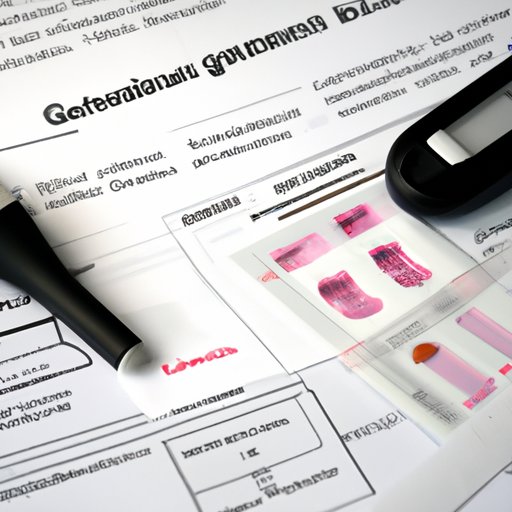
Introduction
Expecting parents look forward to finding out the gender of their baby, but many may wonder how many weeks are required to determine the baby’s gender accurately. This is an essential issue for parents-to-be as they prepare for their child’s arrival, including selecting clothing, decorations, and baby names. This article will explore the science behind gender detection and discuss the different methods, accuracy, reliability, common myths, waiting timeframes, factors that affect gender detection, and guidelines for parents-to-be.
Understanding the Science: How Many Weeks is Required to Determine Baby’s Gender?
The development of a baby involves complex biological processes that start from the moment of conception. The baby’s gender is set at fertilization – females have two X sex chromosomes, and males have one X and one Y sex chromosome. Hormonal and genetic factors determine how these sex chromosomes develop into male or female genitalia.
Gender detection through ultrasound can occur as early as 13 weeks of gestation. However, the most accurate results occur between 18 to 20 weeks, when the baby’s genitalia are visible on the ultrasound. In contrast, gender detection through genetic methods, such as amniocentesis or chorionic villus sampling (CVS), can be performed earlier, as early as 10 weeks. These procedures are invasive and carry some risks, making them less popular choices for gender detection. Anatomical detection through an ultrasound is currently the most commonly used method for gender determination during pregnancy.
The Different Methods: A Synopsis of Various Techniques to Determine Gender in Different Gestational Weeks
Ultrasound, blood tests, and amniocentesis are the three primary methods used to determine the gender of a baby.
Ultrasound imaging involves the use of high-frequency sound waves to produce images inside the body. During pregnancy, ultrasound can create a picture of the fetus, including its gender. Typically, the first ultrasound is performed at 8 to 12 weeks of gestation, while another ultrasound around 18 to 20 weeks confirms the gender. Blood tests that detect fetal DNA, such as the MaterniT21 or Harmony test, can be performed as early as 10 weeks of pregnancy, but are more commonly used to detect chromosomal abnormalities.
Amniocentesis is a medical procedure that involves extracting a small sample of amniotic fluid, which surrounds the developing fetus. Amniocentesis testing is also commonly used to test for chromosomal abnormalities but may also detect gender as early as 10 weeks.
In-Depth Analysis: The Accuracy and Reliability of Gender Detection at Different Timeframes
The accuracy and reliability of gender detection are influenced by the method of detection and the gestational age of the fetus. Ultrasound imaging is the most reliable method for gender detection once the genitalia are visible. However, the accuracy decreases with gestational age, potentially due to the position of the baby or limited visibility. Blood tests are highly accurate in detecting the fetal sex chromosomes, with a reported accuracy rate of 99%. Invasive genetic methods, such as amniocentesis and CVS, also have a high level of accuracy and reliability in gender detection.
Debunking Myths: Common Misconceptions About Detecting Gender and the Actual Timeframe
There are a few myths surrounding gender detection during pregnancy. One common myth is that carrying a baby low means you are likely to have a boy while carrying high means you are likely to have a girl. However, this is not supported by scientific evidence. The baby’s position in the womb affects how the mother carries the baby, and this is not an indicator of gender.
Another common myth is that the shape and appearance of the mother’s belly can predict the baby’s gender. Again, this is not supported by scientific evidence, and belly shape is influenced by the mother’s body type, the position of the baby, amniotic fluid, and other maternal factors.
Waiting Game: The Pros and Cons of Waiting Till Later Weeks for a Clearer Gender Result
Parents-to-be may choose to wait until later gestational weeks for gender detection, primarily to increase accuracy and visibility of the genitalia. However, waiting does have some drawbacks, including prolonging the wait for baby’s gender, increased stress levels during the waiting period, and a potential risk of inaccurate gender speculation based on old wives’ tales. Importantly, waiting does not affect the baby’s development and health outcomes.
Factors that Affect the Gender Detection Timeframe: Genetics, Maternal Factors, and Other Variables
Genetics and maternal factors can affect the timeframe for gender detection. For example, maternal weight may obscure the view of the fetus during ultrasound imaging, potentially affecting the accuracy of gender detection. Twins or multiples may also complicate gender detection using some methods, especially ultrasound imaging.
Guidelines for Parents-to-Be: When to Schedule an Ultrasound to Ensure Early and Accurate Detection of Baby’s Gender
It is recommended that parents-to-be schedule an ultrasound between 18 and 20 weeks of gestation to ensure early and accurate detection of their baby’s gender. Performing an ultrasound outside of this timeframe may decrease the accuracy of gender detection or require further testing. However, certain medical conditions may necessitate additional ultrasounds or other gender detection methods.
Conclusion
Finding out the gender of your baby is an exciting moment for expectant parents. This article has explored the science and techniques used to determine a baby’s gender, including ultrasound imaging, blood tests, and amniocentesis. We have discussed the accuracy, reliability, common misconceptions, waiting timeframes, factors that affect gender detection, and guidelines for parents-to-be. Finally, our aim is to provide parents with accurate information to make informed decisions and have a healthy, happy pregnancy.




